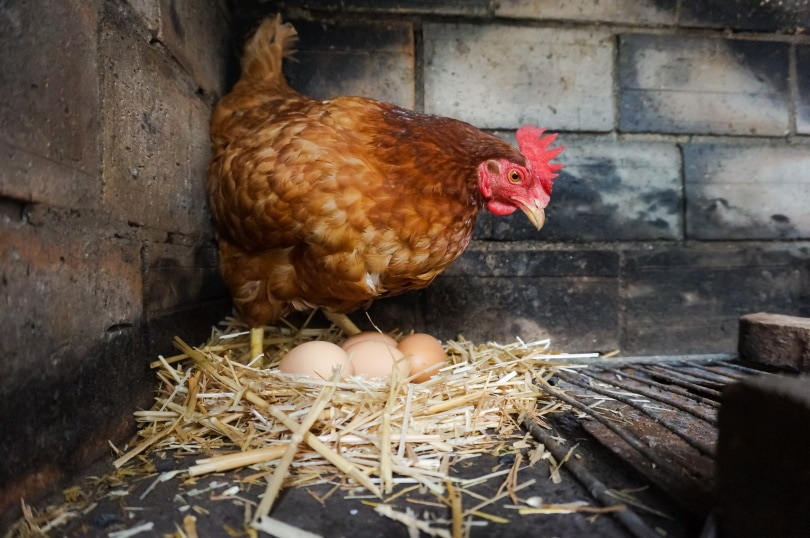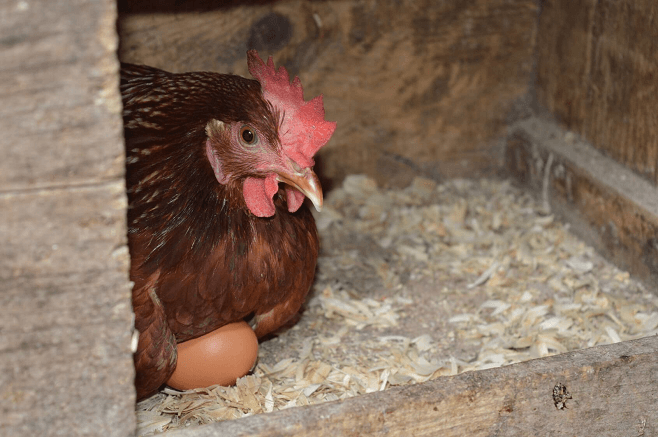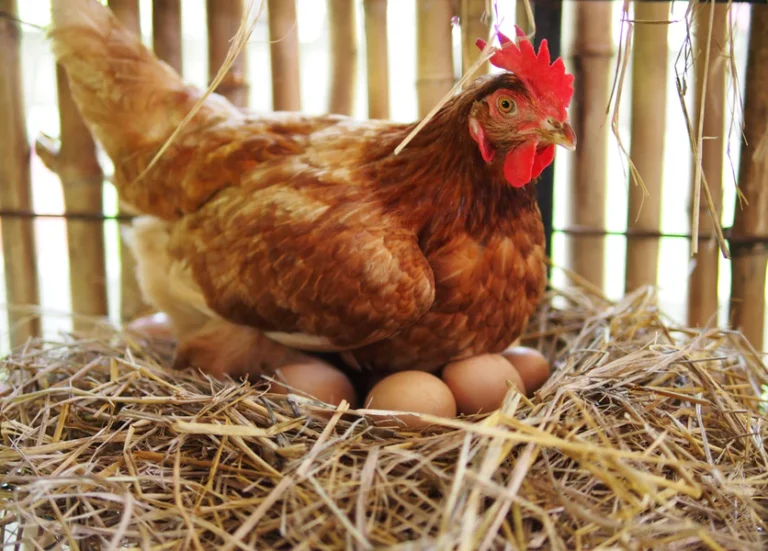Chickens lay eggs through their cloaca, which is a single opening used for reproductive, digestive, and excretory functions. Inside the female chicken’s body, the egg forms in the ovary and then travels down the oviduct, where it is gradually covered in layers of albumen (egg white) and membranes before finally receiving a shell in the uterus. When the egg is fully formed, it is laid through the cloaca, which is the external opening where the egg exits the hen’s body.
What is the Cloaca in a Chicken?
The detailed anatomy of a chicken, particularly the cloaca and the female reproductive system, helps comprehend the intricate process of egg production and laying in chickens.
Description of the cloaca:
Definition and Function
The cloaca is a single opening at the posterior end of the chicken used for multiple functions, including reproduction, excretion, and digestion. It serves as the common opening for the digestive, urinary, and reproductive tracts.
Structure and Location

The cloaca is located at the base of the chicken’s tail. It appears as a small, puckered opening, where waste products, reproductive cells, and eggs exit the chicken’s body.
Adaptations for Reproduction
In female chickens, the cloaca plays a crucial role in laying eggs. During egg-laying, the oviduct contracts and guides the egg through the cloaca for expulsion.
The reproductive system in female chickens
Ovary
Female chickens have two ovaries but typically only the left one is functional.
The ovary is responsible for producing ova (egg cells).
Oviduct
After an ovum is released from the ovary, it enters the oviduct, a long tube-like structure. The oviduct is divided into different sections: infundibulum, magnum, isthmus, shell gland (uterus), and vagina.
Egg Formation Process in the Oviduct
- Infundibulum: This is where fertilization can occur if the ovum encounters sperm. The egg then moves to the magnum.
- Magnum: Albumen (egg white) is added to the egg here.
- Isthmus: Membranes form around the egg.
- Shell Gland (Uterus): The shell is formed and deposited around the egg.
- Vagina: The final part of the oviduct where the fully formed egg is ready for expulsion.
Hormonal Regulation
Hormones play a significant role in regulating the reproductive cycle of female chickens, including ovulation and egg-laying. The pituitary gland releases hormones that stimulate the ovaries to produce eggs.
How Are Eggs Formed in Chickens?
The intricate process of egg formation in chickens, from ovary development to the sequential journey through the oviduct and the formation of different egg components, highlights the complexity and precision involved in the creation of each egg before it is laid by the hen.
Egg development in the ovary
Follicular Development
- Female chickens possess two ovaries but typically only the left ovary is functional.
- Within the ovary, small clusters of cells called follicles house the ova (egg cells).
- Hormonal changes trigger the growth and development of these follicles.
Ovulation
- When an ovum (immature egg) reaches maturity, it is released from the follicle on the surface of the ovary.
- The ovum then moves into the infundibulum, the funnel-like structure at the beginning of the oviduct.
Journey through the oviduct
Infundibulum
- If fertilization occurs (sperm meets the egg), it happens in the infundibulum.
- The egg spends about 15 minutes to several hours in this region.
Magnum
- The egg enters the magnum, the longest segment of the oviduct.
- Albumen, or egg white, is secreted here and gradually covers the egg.
- The egg spends around 3 hours in the magnum.
Isthmus
- The egg moves into the isthmus, where membranes start forming around it.
- Membranes serve as protective layers surrounding the egg.
- This stage takes approximately 1.5 hours.
Shell Gland (Uterus)
- The egg reaches the shell gland or uterus.
- Calcium carbonate and other minerals are deposited around the egg, forming the eggshell.
- The shell formation process takes about 20 hours.
Vagina
- The egg passes through the vagina, where it receives its final coating and any remaining debris is removed.
- It takes approximately 20-25 hours for the egg to move through the entire oviduct.
Formation of egg components (albumen, membranes, shell)
Albumen
- The albumen is primarily composed of water and protein.
- It serves to protect and nourish the developing embryo if fertilization occurs.
Membranes
- Membranes, including inner and outer shell membranes, develop in the isthmus.
- They provide a barrier against bacteria and protect the egg’s contents.
Eggshell
- The shell is formed in the shell gland (uterus).
- It consists mainly of calcium carbonate and provides protection to the egg’s contents.
How Does a Chicken Lay Eggs?

The intricacies of the egg-laying process in chickens sheds light on the biological and physiological mechanisms involved in ensuring the proper formation and expulsion of each egg.
Triggering the laying process
Hormonal Regulation
Hormonal changes, particularly an increase in the hormone called luteinizing hormone (LH), play a significant role in triggering the laying process. LH surge stimulates the mature egg’s movement into the infundibulum, preparing for oviposition (egg laying).
Environmental and Behavioral Cues
External factors such as daylight length, temperature, and nesting conditions can influence the onset of egg laying. The hen’s behavior, feeling safe and comfortable in a suitable nesting area, encourages egg laying.
Contractions and movement of the egg through the oviduct
Once the laying process is triggered, the muscles of the oviduct contract rhythmically, aiding the movement of the egg from the infundibulum through the different sections of the oviduct.
These contractions help propel the egg through the magnum, isthmus, shell gland, and vagina, where each part of the egg (albumen, membranes, shell) is sequentially added or formed.
Final stages before egg laying
Uterine Contractions
As the egg nears completion, stronger contractions of the uterus occur to apply the final layers of shell and prepare for expulsion. The shell receives its last mineralization in this stage.
Vaginal Cleansing
The vagina provides a final coating to the egg and removes any remaining debris. This stage ensures the egg’s surface is clean before it is laid.
Egg laying through the cloaca:
Cloacal Expulsion
Once the egg is fully formed and ready for laying, the hen assumes a squatting posture. The muscular contractions around the cloaca push the egg out gently but forcefully.
Protective Coating
As the egg passes through the cloaca, it receives a protective coating of mucus to facilitate its smooth passage and protect it from bacterial contamination.
Laying Frequency
Hens generally lay eggs every 24-26 hours, with the process repeating after each egg is laid.
FAQ’s
Do we eat unfertilized eggs?
Yes, the eggs commonly consumed are unfertilized.
How do chickens lay eggs without a male?
Chickens can lay eggs without a male through a process called parthenogenesis, where the eggs develop without fertilization.
How big is a woman’s egg?
A woman’s egg, or ovum, is microscopic, approximately 0.12 millimeters in diameter.
Is the egg we eat a chicken?
No, the egg we typically consume is not a chicken; it is an unfertilized reproductive product of a hen.
Is a chicken egg fertilized by sperm?
The eggs we commonly eat are unfertilized; hence, they haven’t been fertilized by sperm.
Who lays the eggs we eat?
The eggs we commonly eat are laid by hens, specifically domesticated laying hens bred for egg production.
Final Words
In conclusion, understanding where eggs come from in chickens involves knowing about their body parts like the cloaca and how the female reproductive system works. Eggs begin in the ovaries, travel through the oviduct, and get their components like the shell and egg white before being laid.
Furthermore, this process is triggered by hormones and environmental cues. Finally, the egg is laid through the cloaca. Taking care of hens is essential for good egg production. Knowing this process helps appreciate the effort that goes into every egg we enjoy!

